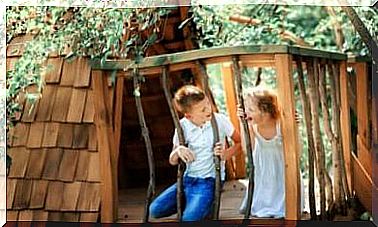Waldorf Pedagogy: 5 Keys To Education – Being Parents

This method is one of the best known alternative education systems to date. Waldorf pedagogy was developed at the beginning of the 20th century.
It stems from the research and teachings of German philosopher Rudolf Steiner, who sought development-based learning appropriate for each age group. That is to say, it is a balanced education adapted to the development of each child.
Its methodology favors the formation of its own capacities. But the importance does not lie only in the studied contents, but also in the necessary processes to assimilate them.
To do this, it divides the development of education into four stages with different educational activities.
The 5 pedagogical keys of Waldorf education
The Waldorf method is quite peculiar and has therefore found many detractors.
It offers a much freer education system than the traditional one, considering secondary academic disciplines, because evaluating a child based on his level of knowledge can affect his self-esteem. Let’s see the keys to Waldorf education:

- We strengthen the development of artistic skills and imagination. According to Waldorf pedagogy, these skills, the natural expression of children, are the best way to develop and acquire knowledge.
- There are no exams. By avoiding the standardization of students, this method aims to promote the motivation and development of each student, protecting their self-esteem. By advancing at their own pace, children benefit more from learning and discover their interests better.
- Each child creates their own textbook. In accordance with the principles of the previous point, there is no textbook. Each student, based on their daily work and personal experiences, creates their own personalized book.
- The school environment is an extension of the home. It’s not just about warm colors, open spaces with lots of nature and handmade toys. A tutor accompanies them every step of the way, bonding with students and family to understand and help children in the best possible way.
- We promote teaching – and learning – free, spontaneous and natural. The student’s interaction with his environment is fundamental. Teaching is not limited to teaching certain concepts, but to understand the “how” of it, which encourages students to form their own opinion on the environment in which they operate.
The stages of Waldorf education
As in other education systems, in Waldorf pedagogy, teaching begins with early childhood education.
This stage, marked by the first steps of the children, seeks in particular a safe, affectionate and structured environment in which they can experiment.
They will learn by imitation and by playing, with activities inserted in a coherent and familiar context for them. Thus, in addition to developing their motor skills, they will learn to build relationships and cultivate creativity, imagination and a sense of initiative.
They will also be able to acquire good habits of memory, order and, above all, curiosity and enjoyment of the natural world.
The educational cycle in 12 lessons
This cycle is generally divided into 6 years of primary, 4 of college and 3 cycles of high school. However, in Waldorf pedagogy, primary consists of 8 courses and middle and high school 2 each.
Each of these stages will focus on various activities adapted to the development of each child.
“Everything that a child learns during his school years should be able to apply in his practical life”
-Rudolf Steiner –

Primary education will seek to ensure that the child begins to discover the world, thus nurturing their interest and enthusiasm.
Arts education enables conceptual learning to be approached , prioritizing process, transformative capacity, and holistic understanding.
In college, the main goal is to motivate students so that they can formulate their own points of view. Instead of being limited to the “what”, to learn a concept, they will explore the “how” it was achieved or can be achieved.
The experimentation and research, with more scientific work is at the heart of classroom activities, but without forgetting the arts.
Finally, in the high school years, they can choose between the methods of the technological baccalaureate, social sciences, humanities and art.
The importance of this phase is that it will be the one that shows adolescents how they can act in the world, that is, to change it instead of getting carried away. The activities will combine study and practice from the industrial as well as social field.









